
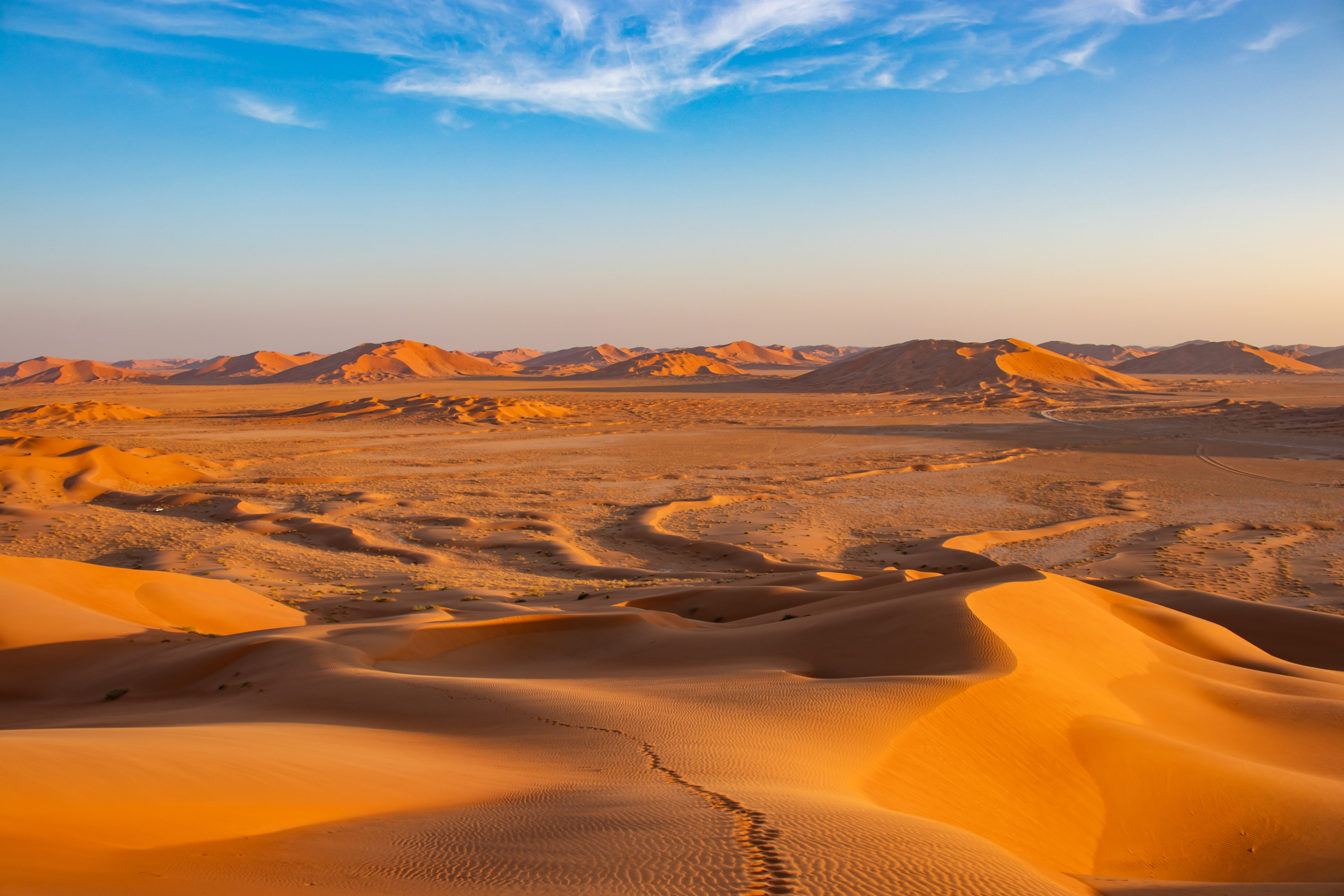
The Hidden Wonders of the Empty Quarter Desert: What You Need to Know
Picture a sea of sand so big it could engulf entire countries. The Empty Quarter desert spans four Middle Eastern nations and stands as Earth’s largest continuous sand desert. This mesmerizing expanse has tested explorers and scientists for centuries.
This seemingly lifeless landscape holds countless secrets beneath its golden dunes. Each empty quarter safari brings new mysteries to light. Scientists have found evidence of ancient civilizations and unique wildlife that adapted to this extreme environment.
In this piece, we’ll take you through the hidden wonders of this remarkable desert. You’ll learn about its geological marvels and surprising ecosystems that thrive beneath its changing sands. We’ll also explain modern exploration methods and the conservation challenges this unique region faces today.
Geographical Marvel of the Empty Quarter
The Empty Quarter desert stands as a geological masterpiece that goes beyond imagination. This remarkable stretch of sand covers 650,000 square kilometers, making it the largest continuous sand desert worldwide.
World’s Largest Sand Desert
The terrain spans across four countries – Saudi Arabia, Oman, Yemen, and the United Arab Emirates. The desert’s story lies in its elevation, reaches 2,000 feet in western regions and drops to about 600 feet eastward. The landscape captivates visitors with its distinctive reddish-orange sand, which gets its color from feldspar minerals.
Formation and Geological History
The Empty Quarter’s Tale began about 2 million years ago in the Quaternary Era. Geological studies showed this massive basin once laid beneath the Arabian Gulf waters. Several factors shaped its formation:
- Wind patterns from the Gulf Sea
- Pressure from northern glacier caps
- Fluctuating water levels
- Erosion of surrounding mountain ranges

Unique Sand Dune Formations
The Empty Quarter desert reveals an impressive range of dune formations. Two main dune types dominate the landscape:
- Transverse Dunes
-
- Stand perpendicular to dominant winds
-
- Feature dramatic barchan dunes up to 250 meters high
-
- Create distinctive barchanoid ridges through linkage
- Linear Dunes
-
- Align parallel to prevailing winds
-
- Extend up to 200 kilometers
-
- Stand between 20 and 160 meters tall
The dune’s evolution happens through deflation on the windward side and accretion on the leeward face. The southeastern region features remarkable star dunes with multiple arms. The western areas showcase vast corridors of linear dunes, shaped by the powerful northern winds.
Life in the Extreme
Life exists in unexpected places. The Empty Quarter desert amazes us with nature’s resilience in its harsh environment. The most hardy creatures face challenges here, yet we see remarkable life forms that have become skilled at survival.
Surviving Desert Climate
Our Empty Quarter safari trips show the brutal climate extremes firsthand. Summer temperatures soar above 50°C (122°F), and annual rainfall barely reaches 50mm. Some areas can stay dry for twelve straight months without a single raindrop.
Unique Desert Ecosystems
The harsh conditions don’t stop plant communities from thriving here. The ecosystem supports remarkable vegetation adaptations:
- Woody perennial Calligonum comosum grows along unstable dune crests
- Hardy grasses like Neurada procumbens appear after rare rainfall
- Deep-rooted Acacia trees survive on the desert’s outskirts
- Salt-tolerant species thrive in mineral-rich soils
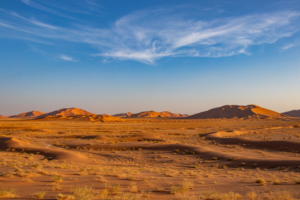
Adaptation Strategies of Desert Species
The sort of thing I love is the ingenious survival strategies desert creatures have developed. The Arabian oryx, one of the desert’s iconic residents, can go weeks without drinking water and gets moisture only from dew and plant matter. The sand cat and Arabian sand gazelle have become “non-water drinkers” that get enough hydration from their food.
Desert reptiles show impressive adaptations too. They raise their bodies off the scorching sand to create an insulating air layer. Their white bellies reflect heat, and some species “swim” through the sand to escape extreme temperatures.
The Empty Quarter’s wildlife has developed remarkable night behaviors to handle the heat. Many species become active during cooler night hours to conserve precious moisture and avoid the drying effects of daytime temperatures. The hardy camel, which we often see during our explorations, has specialized blood characteristics that minimize fluid loss during long waterless periods.
These adaptations make the Empty Quarter desert a living laboratory of survival ingenuity, not just a geographical marvel.
Hidden Treasures Beneath the Sand
The Empty Quarter desert’s sands hide a rich source of secrets that amaze us with each new find. Our exploration uncovers historical layers that challenge our understanding of this extraordinary landscape.
Ancient Lakes and Rivers
The arid landscape holds proof of a remarkable past dominated by water. Our research identifies two distinct periods when lakes covered the Empty Quarter desert: 37,000 to 17,000 years ago and 10,000 to 5,000 years ago. These lakes were substantial – we estimate more than a thousand existed, some as deep as 10 meters. The fossilized remains tell a fascinating story of a thriving ecosystem from long ago.
Archeological Discoveries
Our archeological expeditions now use advanced AI technology to reveal remarkable findings beneath the sand:
- Pristine fossilized hippo teeth and water buffalo bones
- Stone tools and implements dating back 10,000 years
- Ancient lake bed sediments containing clam shells
- Evidence of human settlements along prehistoric shorelines
Synthetic aperture radar (SAR) technology has changed how we explore. We can now see beneath the sand with remarkable clarity and detect hidden structures within 50 centimeters.
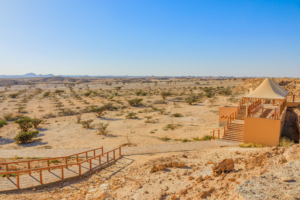
Modern Oil Exploration
Ancient treasures amaze us, yet modern discoveries continue to surface. Recent explorations have yielded major oil and gas findings in the Empty Quarter. Our latest surveys have identified several new fields:
|
Discovery Type |
Location |
Production Rate |
|
Natural Gas |
Al-Jahaq Field |
5.3 million cubic feet/day |
|
Oil |
Al-Ladam Field |
5,100 barrels/day |
|
Natural Gas |
Al-Katuf Field |
7.6 million cubic feet/day |
These discoveries reshape our understanding of the region’s resources and the future of energy exploration in the Empty Quarter desert. Our empty quarter safari expeditions often pass these exploration sites, showing the desert’s hidden wealth.
Desert Exploration Adventures
Desert adventurers have been drawn to the Empty Quarter desert’s vast landscapes for almost a century. The footsteps of legendary explorers can still be traced while modern tourism has reshaped this once-forbidden terrain.
Historic Expeditions
Bertram Thomas’s groundbreaking journey in 1931 marked our first real understanding of the Empty Quarter. His achievement amazes us – crossing 1,300 kilometers in just 59 days. Wilfred Thesiger’s multiple crossings between 1946 and 1950 were maybe even more impressive. He mapped the region carefully and documented his experiences in the acclaimed book “Arabian Sands.”
Notable Empty Quarter Expeditions:
|
Year |
Explorer |
Achievement |
|
1931 |
Bertram Thomas |
First Western crossing |
|
1946-50 |
Wilfred Thesiger |
Extensive mapping |
|
1999 |
Jamie Clarke |
First Western crossing in 50 years |
|
2020 |
Max Calderan |
First west-to-east solo crossing |
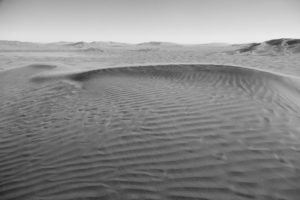
Modern Desert Tourism
The Empty Quarter has evolved from an explorer’s challenge into a luxury adventure destination. Empty quarter safari experiences now combine traditional desert activities with modern comforts. Visitors at the magnificent Qasr Al Sarab Desert Resort can enjoy:
- Dawn desert walks and camel treks
- Dune bashing in modern 4×4 vehicles
- Traditional falconry demonstrations
- Stargazing under pristine desert skies
Safety and Preparation Tips
Desert exploration over the years has taught us that preparation matters most. Experienced guides should accompany your Empty Quarter adventure. Solo expeditions should never be attempted. The desert’s extreme conditions need careful timing – October to April provides the best weather.
High-SPF sunscreen, adequate water supplies, and appropriate clothing for temperature changes are must-have items for any desert journey. Traditional customs and local practices deserve respect even in luxury settings to improve your desert experience significantly.
Conservation and Future Challenges
Our work as conservationists in the Empty Quarter desert puts us at a turning point in this ancient landscape’s history. The desert’s preservation challenges match its immense size.
Environmental Protection Efforts
Oroug Bani Maradh stands as the life-blood of our preservation work. Our complete programs now include:
- Rehabilitation of endangered species through breeding programs
- Protection of native flora and fauna
- Development of environmental education programs
- Local community participation in biodiversity preservation
Our conservation breeding programs have achieved remarkable results. The Arabian oryx moved from ‘endangered’ to ‘vulnerable’ status in 2011, marking a major win for preservation.
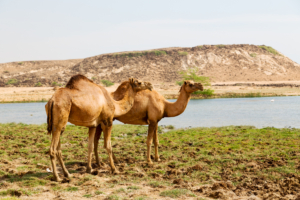
Climate Change Effect
Research points to worrying trends for the Empty Quarter’s future. Climate projections for 2041-2050 show:
|
Climate Factor |
Predicted Change |
|
Temperature |
Significant increase across all regions |
|
Precipitation |
Decline in southern Empty Quarter |
|
Heat Index |
Rising frequency of extreme heat days |
|
Soil Moisture |
5-10% increase in southern regions |
Rising temperatures combined with humidity levels could make certain areas uninhabitable. Our empty quarter safari expeditions have already shown changes in wildlife patterns and vegetation distribution.
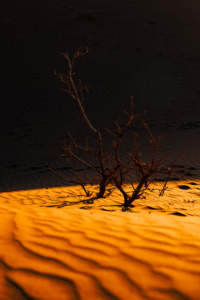
Sustainable Development Initiatives
Conservation and development needs require careful balance. Current initiatives include:
The EQ-Power Project reduces diesel fuel usage through eco-friendly alternatives. New eco-tourism guidelines protect the desert’s fragile ecosystem while allowing controlled visitor access.
Local communities help create sustainable grazing management plans and low-impact tourism strategies. Protection extends to over 400 endangered plant species in the Arabian Peninsula, focusing on those adapted to extreme desert conditions.
International conservation organizations strengthen our research capabilities through advanced monitoring systems. These mutually beneficial alliances become vital as we tackle ecosystem preservation while adapting to climate change effects.
Conclusion
The Empty Quarter desert shatters our preconceptions of barren wastelands. This vast expanse covers 650,000 square kilometers across four nations and shows nature’s resilience and complexity in remarkable ways.
Life flourishes here despite overwhelming odds. The resourceful Arabian oryx and deep-rooted Acacia trees have made this harsh environment their home. Ancient waterways once carved through these endless dunes, and their archeological treasures continue to change our understanding of human history.
Explorers have made this challenging terrain more available to visitors, but its future remains uncertain. The unique ecosystem faces threats from rising temperatures and development pressures. Our efforts to preserve it have become more significant than ever.
This remarkable place teaches us powerful lessons about adaptation and survival. The seemingly harsh environment conceals unexpected riches beneath its surface. We strive to protect this extraordinary landscape for future generations while its mysteries continue to unfold. The Empty Quarter proves that Earth’s most extreme environments often guard its most extraordinary secrets. Wander far, explore deep join our next tour Book Now!
